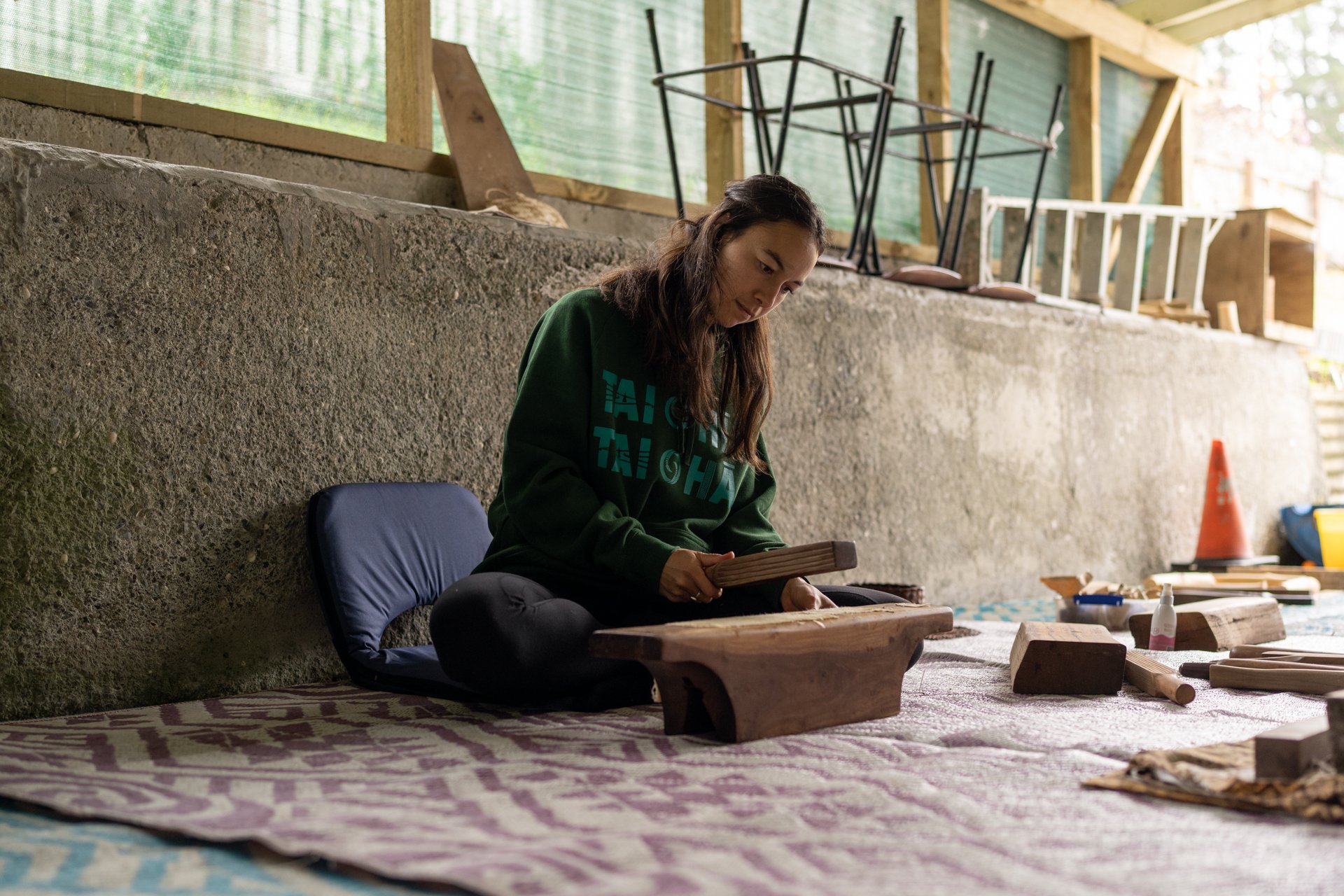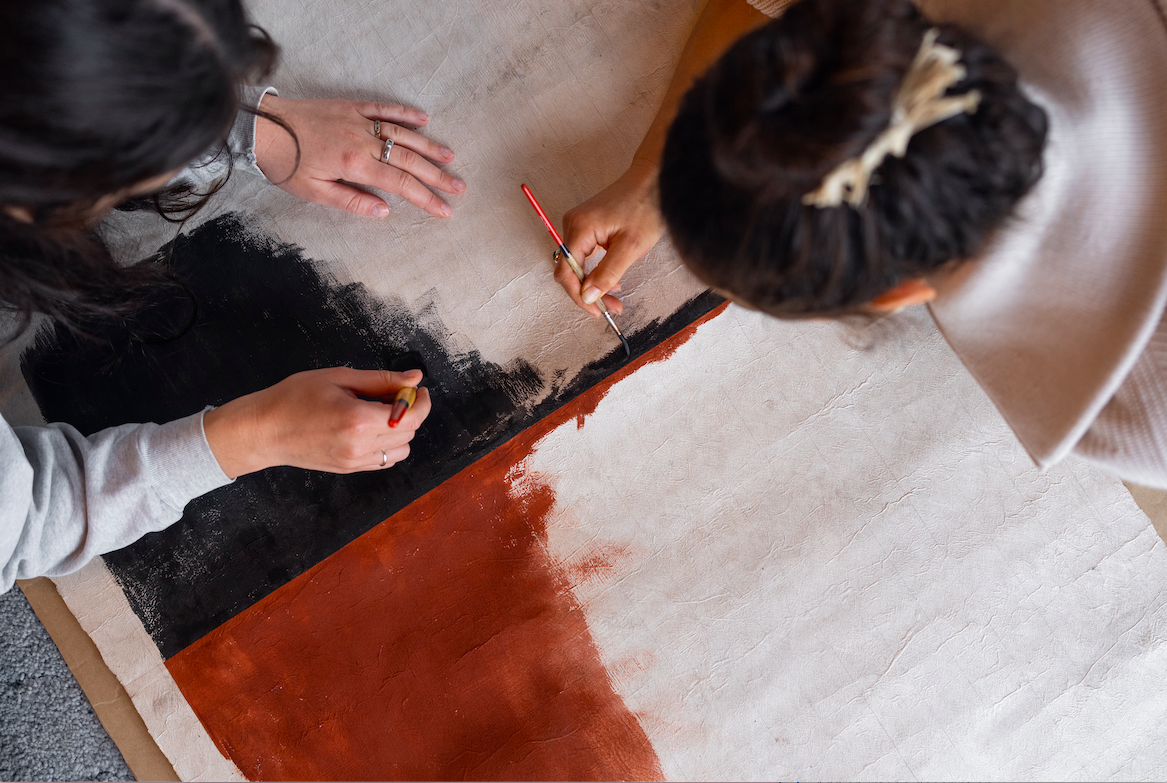NIKAU HINDIN
Nikau holding one of her thirteen pieces that travelled to Japan to be exhibited as apart of aichi 2022
Two of Nikau's finished pieces that represent the Winter Solstice and Summer Solstice, Te Tīpare o Hine Takurua and Te Tīpare o Hine Raumati
Nikau in the process of beating out the aute
Nikau and Rongomai adorning aute with kōkōwai
Te roopu Aute holding their mahi at Ngāi Tūpoto Marae. Left to right: Rongomai, Mikara, Nikau, Moana, Lydia, Twilight, and Dina
Nikau planting Aute
FEATURED: Nikau Hindin - Moving in the ways of our tūpuna
Ko Maungataniwha te maunga
Ko Tapuwae te awa
Ko Ngatokimatawhaorua te waka
Ko Ngai Tūpoto te marae
Ko Ngahuia te wahine Rangatira
Ko Ngāpuhi me Te Rarawa ngā iwi
Ko Ngai Tūpoto te hapu
A thoughtful and inspiring ringatoi from Ngāi Tūpoto, of Te Rarawa and Ngūpuhi descent, Nikau has dedicated her life to remembering and reviving the art of aute here in Aotearoa. Her practice took shape during her exchange in Hawai’i and is built upon mātauranga from across Te Moana Nui a Kiwa grounded in the cycles of te taiao. As an artist, Nikau embodies the cyclical nature of our world: what she creates is both of this whenua and for this whenua. Her pieces mark time in a uniquely Māori way, reflecting the maramataka and celestial navigation mapping, inspiring us to remember and move in the ways of our tūpuna.
Growing up in Tāmaki, surrounded by creative women, Nikau always knew she was destined to be an artist. Her māmā and aunty are both clothes makers and Nikau recalls spending time around the cutting tables which gave her an early understanding and love for the creative process. Nikau’s grandmother was also a painter and Nikau remembers her grandmother making books for her. With inspiring creative role models and a strong whānau around her kura, Te Uru Karaka Newtown Central School, Nikau grew up immersed in her culture. From a young age Nikau was drawn to traditional painting and she reflects that it wasn’t until later that her painting practice began to fully intertwine with her māoritanga in the ways it does now.
After finishing kura, Nikau attended Elam School of Fine Arts where she was introduced to contemporary and conceptual art practices and completed a Bachelor of Arts in Māori Studies. Nikau reflects on some of the challenges she often faced as an Indigenous artist learning in a Western art institution which often lacked the space and time to aro ki ngā mahi o ō mātou tūpuna. However, in many ways those challenges encouraged Nikau to follow her instincts and search for experiences that could affirm what she already knew and was learning through her Māori studies.
One of these experiences was living in Hawai’i for a year on an exchange programme during her undergraduate degree. It was on this haerenga that Nikau was able to learn about celestial navigation and deepen her connection to the moana through sailing and surfing. She reflects on this time as being transformative not only for her art practice, but in how she understands the world and the notion of time. This time spent sailing and moving in the ways of her tūpuna allowed Nikau to live in the richness of our culture, and in turn, motivated her to ask herself what richness can she add to its future. One waka in particular, Hōkule‘a, illustrated to Nikau just how powerful and impactful art can be for our communities. Nikau reflects on how this vessel, Hōkule‘a, not only carries the Hawaiian community, but how it also carries their stories and ways of being in the world that continues, and will continue to inspire future generations.
This motivation to create art purposefully for our people and in ways that reaffirm how we see the world continues to be a driving force behind all of Nikau’s mahi. Whilst her most recent pieces seem to effortlessly weave together aute, kōkōwai, celestial mapping, and mātauranga to form its own unique reo, this did not come together straight away. Nikau spent five years focused on aute alone, refining the processes of harvesting and beating the cloth before adorning her pieces with earth pigment. She believes this time of kurahuna is crucial for emerging ringatoi to hone their craft and she herself is a proponent of mastery, demonstrating the excellence that comes from mastering one's craft. For Nikau, this time was also about respecting the mana of aute and recognising that in the times of our tūpuna it was precious. Therefore, she felt if she was going to adorn it that it would need to be something worthy of aute. Nikau explains further that materials have meanings and a whakapapa in and of themselves and therefore sometimes simply honouring your materials can be powerful enough. Part of her decision-making when it came to adorning her aute was wanting to make art that is useful and art that can teach and reinforce our stories and knowledge.
Nikau completed her honours and masters degree focused on aute and whilst her practice has evolved over the last decade she reflects on how her objectives have remained much the same. These objectives include refining the cloth and the process, making good quality tools and beaters, to plant and cultivate, creating groves of aute plants in Aotearoa, to adorn the cloth, and to wānanga and teach others the process. Nikau has been following the same processes for nine years now but she explains there is always more to learn and she will continue to honour where her work comes from and the whakapapa that has built her practice. Bark cloth and tapa practices are strong across the islands and she acknowledges she doesn't create in a void, and that nothing she creates exists in isolation. There are lots of differences across the Pacific from how the plant grows, to how the community uses it and right down to the tricks different ringatoi have developed in their practice.
Nikau talks about her recent wānanga and mahi with Toi Ngāpuhi and explains how important it is for our people to be learning our toi on our whenua. She feels grateful to be involved as one of the pouako and to have had the opportunity to teach Tai o Hī nō Ngāpuhi has been a privilege for her. Nikau reflects on the latest wānanga held at her very own Ngāi Tūpoto Marae, and how exciting it was for her to see her own whānau inspired to do more wānanga in the future. Nikau is proud to be from Ngāpuhi. She comes from hardworking and humble people, who have spent their lives working the whenua and growing the maara kai. For her, going home is always a powerful source to enrich her practice. Alongside the gardeners and tool makers, Te Tai Tokerau also has the best climate for growing aute.
Nikau hopes that her toi encourages people to be curious about our taonga tuku iho. She believes there is still so much we do not know and now understands the limitless potential that comes through repeatedly pursuing excellence in our art forms. Nikau has learnt to be a lot more resolute in who she is and what she knows, reflecting that her hononga with aute has, and will continue, to influence how she moves through the world around her.
Written by Tai o Hī Tai o Hā Writing Intern Amelia Blundell (Ngāpuhi, Ngāti Kahu ki Whangaroa)






